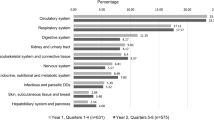Abstract
The number of medically uninsured people in the United States rose from 46 million in 2008 to an astonishing 50.7 million in 2009. This population is unable to seek medical care due, in part, to the decrease in employment-based health insurance and the increase in the cost of health care. Free health clinics exist to ensure access to health care by providing a safety net for underserved populations, ultimately decreasing health disparities among people of different socioeconomic statuses. The purpose of this study was to determine the demographic characteristics of the uninsured people who utilized a free health clinic and the purpose for their visits. Investigators gathered information from over 2,000 hand-written medical records to determine whether the demographic characteristics and health conditions of the uninsured differed from the general population. While there was no predominate medical condition in this population, special attention is needed to the prevention of smoking and obesity among the uninsured. This uninsured population had a significantly higher rate of smoking (P < 0.01) and obesity (P < 0.05) than the general population. In addition to treatment for medical conditions, 1 in 4 patients came for a physical exam. This study adds to the literature by describing characteristics of a free clinic population and their medical conditions. This research can contribute to the improvement of a health care delivery system that is challenged in providing access to medical care by low-income and uninsured populations.
Similar content being viewed by others
References
U. D. Department of Commerce. (2010). Income, poverty, and health insurance coverage in the United States: 2009. U.S. Census Bureau.
Davis, K. (2010). New report on national health expenditures underscored need for comprehensive health care reform. The Commonwealth Fund. Retrieved from http://www.commonwealthfund.org/Content/News/News-Releases/2010/Feb/New-Report-on-National-Health-Expenditures-Underscores-Need-for-Comprehensive-Health-Care-Reform.aspx.
United States Department of Labor. (2010a). Displaced workers summary. Bureau of Labor Statistics.
United States Department of Labor. (2010b). Local area unemployment statistics. Bureau of Labor Statistics.
Rosenbaum, S., Jones, E., & Shin P. (2010). Community health centers: Opportunities and challenges of health reform. The Henry Journal of Kaiser Family Foundation. Retrieved from http://www.kff.org/uninsured/8098.cfm.
Hitt, E. (2010). Free clinics in the United States serve millions each year. Archives of Internal Medicine, 170, 946–953.
Issacs, S. L., & Jellinek, P. G. (2007). Watch report: Is there a (volunteer) doctor in the house? Free clinics and volunteer physician referral networks in the United States. Health Affairs, 26(3), 871–876.
Nadkarni, M. M., & Philbrick, J. T. (2003). Free clinics and the uninsured: The increasing demands of chronic illness. Journal of Health Care for the Poor and Underserved, 14(2), 165–174.
Keis, R. M., DeGeus, L. G., Cashman, S., et al. (2004). Characteristics of patients at three free health clinics. Journal of Health Care for the Poor and Underserved, 15, 603–617.
Shroeder, A. (2009). The economic recession and nonprofit safety-net health centers and clinics in the United States. Santa Barbara, CA: Direct Relief International. Retrieved from www.directrelief.org.
Redlener, I., & Grant, R. (2009). America’s safety net and health care reform—What lies ahead? New England Journal of Medicine, 361(23), 2201–2204.
Wilper, A. P., Woolhandler, S., Lasser, K. E., et al. (2008). A national study of chronic disease prevalence and access to care in uninsured U.S. adults. Annals of Internal Medicine, 149(3), 170–176. 7p, 4 charts.
Champaign County Christian Health Center. Retrieved on November 15, 2010 from www.ccchc2003.org/home.
County Health Rankings. Snapshot 2010: Champaign, IL. Retrieved from www.countyhealthrankings.org/illinois/champaign.
U.S. Department of Commerce. (2010). State and county quick facts: Illinois. U.S. Census Bureau.
Illinois Department of Public Health. (2009). Behavioral risk factor surveillance system. County level prevalence data. Champaign, 2007–2009.
U. S. Department of Health and Human Services. (2010). National heart, lung, and blood institute. Categories for blood pressure levels in adults.
Center for Disease Control and Prevention. (2010). High blood pressure facts. National Center for Chronic Disease Prevention and Health Promotion, Division for Heart Disease and Stroke Prevention.
U.S. Department of Health and Human Services. (2008). The numbers count: Mental disorders in America. National Institute of Mental Health.
Illinois Department of Public Health. (2010). Men’s health. Office of Men’s Health.
American Heart Association. (2010). Risk factors and coronary heart disease. Retrieved from http://www.americanheart.org/presenter.jhtml?identifier=4726.
U. S. Department of Health and Human Services. (2009). Health disparities: A case for closing the gap. HealthReform.gov.
Hing, E., Hall, M. J., Xu, J., & National Health Statistics Reports. (2008). National hospital ambulatory medical care survey: 2006 outpatient department summary. Atlanta, GA: Centers for Disease Control and Prevention.
Behavioral Risk Factor Surveillance System. County level prevalence data. Champaign, 2007–2009. Springfield, IL: Illinois Department of Public Health.
Behavioral Risk Factor Surveillance System. (2009). Prevalence and trends data. Centers for Disease Control and Prevention.
Community Health Status Indicators. (2009). Vulnerable populations. Champaign County, IL: Department of Health and Human Services.
Office of Applied Studies. (2007). Tables of Model based estimate (50 States and the District of Columbia), by measure. Department of Health and Human Services, 2006–2007.
U.S. Census Bureau. (2008). Current population survey: Annual social and economic supplement 2007. Washington, DC: U.S. Department of Commerce.
Author information
Authors and Affiliations
Corresponding author
Rights and permissions
About this article
Cite this article
Notaro, S.J., Khan, M., Bryan, N. et al. Analysis of the Demographic Characteristics and Medical Conditions of the Uninsured Utilizing a Free Clinic. J Community Health 37, 501–506 (2012). https://doi.org/10.1007/s10900-011-9470-7
Published:
Issue Date:
DOI: https://doi.org/10.1007/s10900-011-9470-7



